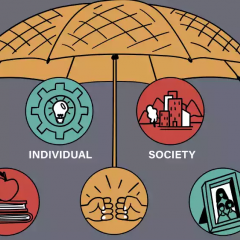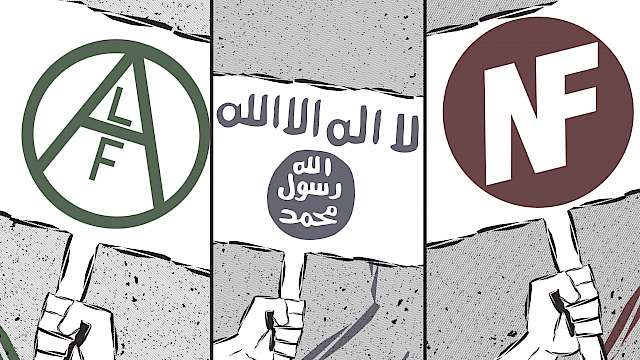Overview
- This is the first of three reports analysing Siege Culture from a subcultural perspective with a focus on whether subcultural participation has the potential to be a protective factor against violence.
- It provides an overview of the development of Siege Culture with an emphasis on the role of defiance, youth, style, and organisational fluidity.
- It then goes on to review subcultural theory as currently used in terrorism studies, including a focus on radicalisation and calls for greater attention to be paid to wider social settings.
- The conclusion suggests that Siege Culture can be interpreted as a subculture and that doing so allows for a better and more granular understanding of participation in Siege Culture.
Siege Culture
- Siege Culture is used as shorthand for a distinctive grouping within the extreme-right centred on the book Siege by US neo-Nazi James Mason.
- The core beliefs of Siege Culture are:
- A focus on an imagined community of whites (Aryans), that is fiercely anti-Communist, anti-Semitic, homophobic, and racist in outlook.
- Adherents view themselves as being special, even amongst others in the extreme-right.
- Arrayed against Siege Culture is “the system”, a combination of big brother and the Zionist occupation government (ZOG) filtered through a general loathing of the establishment.
- Supporters believe their interpretation of fascism is fundamental and incorruptible, representing a universal natural truth that cannot be compromised.
- Accelerationism is a core tenet of Siege Culture; participants believe that societal collapse should be hastened through acts of terrorism.
Development
- National Action 2013-2016
- Siege Culture in the UK begins with the creation of National Action in 2013, well before the book Siege re-emerged.
- National Action was intended to be a legal national socialist group with a focus on youth activism and style but was proscribed in December 2016.
- Atomisation and Americanisation: 2016-17
- Siege was (re)popularised on the web forum Iron March from 2016 onwards.
- Siege and author James Mason were championed by US neo-Nazi group Atomwaffen Division.
- Coupled with the use of distinctive aesthetics, shared internationally, this growing profile resulted in the emergence of an identifiable Siege Culture.
- Cultic Drift 2017-2021
- From 2017 there was clear evidence of a growing influence of spirituality and in particular Satanism in Siege Culture.
- New leadership within Atomwaffen exhibited ties to left hand path Satanism and this was echoed in the UK group Sonnenkrieg Division.
- The cultic phase of Siege Culture in the UK produced some of the most lurid headlines and concerning details, including possession of indecent images of children and interest in and actual cases of sexual violence.
The non-violence Paradox
- Siege, despite its militant presentation and connections to violence (including murder) and terrorist plotting activity, resulted in fewer successfully completed terrorist attacks than might have been expected.
- This can be explained in many ways including the vulnerability of Siege Culture to law enforcement and limiting factors within Siege itself.
- This does not rule out more violence from future ideological developments.
- One further possibility is that the emergent subculture around Siege and related groups acted as a check on serious violence as participants were reluctant to give up access to the benefits provided by the subculture.
Siege Culture as Subculture
- Subcultures are groups of people that stand apart from mainstream norms, often framed as being somehow opposed to the ‘normal’ way of things.
- Subcultures are generally held to be associated with young people.
- Criminal and political explanations for subcultural formation have informed much of subcultural research.
- Rejection of mainstream social norms in many youth subcultures has also been achieved through conscious use of style and expression.
- Subcultural theory has developed some traction within terrorism studies. The dominant preoccupation of this research has been to explain radicalisation using subcultural theory.
- Some research however has focused more on the stylistic appeal and internal meaning of subcultures for participants.
Conclusion
- Siege Culture can be interpreted as a subculture for four reasons:
- The purposeful and defiant inversion of mainstream norms and values.
- The focus on youth.
- The importance attached to style and presentation.
- Its organisation as a complex network of overlapping groups, idealogues, and individual actors.
- This does not mean that the political and revolutionary aspects of Siege Culture can be disregarded, only that they need to be considered alongside the stylistic aspects.
- A subcultural analysis of Siege Culture is useful for research for four reasons:
- The concept of subculture can encompass branded groups, influencers and actor within a broader milieu of shared values and beliefs.
- Subculture allows us to think about and take seriously the stylistic elements present in Siege Culture and their meanings.
- Subculture reflects that adherents are free to participate as much or as little as they like and have lives outside of Siege Culture.
- Most importantly, subculture promotes the possibility of different roles, many non-violent, for individual actors within the broader subculture (discussed more in the next report).
- While uncomfortable, considering Siege Culture from a subcultural perspective provides an opportunity for a more granular understanding of participation and its meaning for participants.
- This in turn allows for a more holistic consideration of the risks to individuals and wider security threats posed by Siege Culture.
Download this report and two others from this series below:
Read more
ABC News (2000) Aryan Nations Gives Up Compound. https://abcnews.go.com/US/story?id=95672&page=1 accessed 31/5/23
ADL (2012) Elohim City. https://www.adl.org/sites/default/files/documents/assets/pdf/combating-hate/Elohim-City.pdf accessed 31/5/22
Anon, (n.d.) On AWD.
Atkinson, M., (2005) Tattoo Enthusiasts: Subculture or Figuration, in Gelder, K. (ed) The Subcultures Reader: Second Edition. London: Routledge, pp 326-342.
BBC (2019b) The neo-Nazi paedophile who plotted to kill https://www.bbc.co.uk/news/stories-44798649 accessed 17/1/23
BBC (2021) Neo-Nazi Andrew Dymock jailed for terror and hate crimes https://www.bbc.co.uk/news/uk-england-somerset-57920928 accessed 9/12/22
Beauchamp, Z. (2019). Accelerationism: The obscure idea inspiring white supremacist killers around the world. https://www.vox.com/the-highlight/2019/11/11/20882005/accelerationism-white-supremacy-christchurch accessed 16/1/23
Becker, H., (1963) Outsiders: Studies in the Sociology of Deviance. New York: The Free Press.
Beckett, A., (2017) Accelerationism: how a fringe philosophy predicted the future we live in https://www.theguardian.com/world/2017/may/11/accelerationism-how-a-fringe-philosophy-predicted-the-future-we-live-in accessed 14/12/22
Bennett, A. (1999). Subcultures or Neo-Tribes? Rethinking the Relationship Between Youth, Style and Musical Taste. Sociology, 33(3), 599–617.
Bugliosi, V., (1974) Helter Skelter: The Shocking Story of the Manson Murders. London: Arrow Books.
Burrows, R., (2018) On Neoreaction https://thesociologicalreview.org/collections/undisciplining/on-neoreaction/ accessed 17/1/23
Campbell, C (2002) The Cult, The Cultic Milieu, and Secularization, in Kaplan, J., and Lööw, H., (eds) The Cultic Milieu: Oppositional Subcultures in an Age of Globalization. Oxford: Alta Mira Press pp12-25
Canadian Association for Security and Intelligence Studies (2021) Accelerationism Theory. https://vtsm.org/wp-content/uploads/2021/04/BN-Accelerationism-2021.04.12.pdf accessed 16/1/23
Celsi, R. L., Rose, R. L., & Leigh, T. W. (1993). An Exploration of High-Risk Leisure Consumption Through Skydiving. Journal of Consumer Research, 20(1), 1. https://doi.org/10.1086/209330
Christchurch Call (n.d.) https://www.christchurchcall.com/ accessed 18/5/23
Clarke, J., Hall, S., Jefferson, T., and Roberts, B., (2006) Subcultures, Cultures and Class. In Hall, S., and Jefferson, T., (eds) Resistance Through Rituals: Youth Subcultures in post-war Britain. London: Routledge, pp 3-59.
Cohen, A., (2005) A General Theory of Subcultures, in Gelder, K. (ed) The Subcultures Reader: Second Edition. London: Routledge, pp 50-59.
Collins, M., (2019) Nazi Terrorist: The Story of National Action. London: Hope not Hate
Cottee, S. (2020). The Western Jihadi Subculture and Subterranean Values. British Journal of Criminology, 60, 762–781.
Cottee, S., (2011) Jihadism as a Subcultural Response to Social Strain: Extending Marc Sageman’s “Bunch of Guys” Thesis. Terrorism and Political Violence 23(5), 730-751.
Counter Terrorism Policing (2020) Neo-Nazi Group Sonnenkrieg Division Proscribed https://www.counterterrorism.police.uk/neo-nazi-group-sonnenkrieg-division-proscribed-counter-terrorism-police/ accessed 16/1/23
CTEC Staff (2022) Archeofuturism and Its Parallels to Militant Accelerationism. https://www.middlebury.edu/institute/academics/centers-initiatives/ctec/ctec-publications/archeofuturism-and-its-parallels-militant accessed 17/5/23
DeSimone, D. (2021) Ryan Fleming: Neo-Nazi paedophile jailed for messaging children https://www.bbc.co.uk/news/uk-england-leeds-56044179 accessed 17/1/23
Gelder, K., (2005) Introduction: The Field of Subcultural Studies, in Gelder, K. (ed) The Subcultures Reader: Second Edition. London: Routledge, pp1-19
Hamm, M. S. (2004). Apocalyptic Violence: The Seduction of Terrorist Subcultures. Theoretical Criminology, 8(3), 323–339. https://doi.org/10.1177/1362480604044612
Hangman (2017) James Mason is Back. Noose.
Hebdige, D., (1979) Subculture: The Meaning of Style. London: Routledge
Hemmingsen, A.-S. (2015). Viewing jihadism as a counterculture: Potential and limitations. Behavioral Sciences of Terrorism and Political Aggression, 7(1), 3–17. https://doi.org/10.1080/19434472.2014.977326
Home Office (n.d.) Proscribed terrorist groups or organisations https://www.gov.uk/government/publications/proscribed-terror-groups-or-organisations--2 accessed 17/1/23
Hope not Hate (2019) Order of Nine Angles. https://hopenothate.org.uk/2019/02/16/state-of-hate-2019-order-of-nine-angles/ accessed 16/1/23
Independent (2021) National Action co-founder had links with Atomwaffen terrorists in US, court hears. https://www.independent.co.uk/news/uk/crime/national-action-atomwaffen-division-raymond-b1951682.html accessed 5/5/22.
Iron March (2015) Next Leap.
Ironmarch.org (n.d.) The Awakening of a National Socialist.
Jackson, P (2020) Transnational neo-Nazism in the USA, United Kingdom and Australia. GW Program on Extremism. https://extremism.gwu.edu/sites/g/files/zaxdzs2191/f/Jackson%20-%20Transnational%20neo%20Nazism%20in%20the%20USA%2C%20United%20Kingdom%20and%20Australia.pdf
Jackson, P. (2014). #hitlerwasright: National Action and National Socialism for the 21st Century. Journal for Deradicalization, 1(Winter 2014/15), 97–115.
Kaplan, J. (1997). ‘Leaderless resistance’. Terrorism and Political Violence, 9(3), 80–95. https://doi.org/10.1080/09546559708427417
Keatinge, T., Keen, F., & Izenman, K. (2019). Fundraising for Right-Wing Extremist Movements: How They Raise Funds and How to Counter It. The RUSI Journal, 164(2), 10–23. https://doi.org/10.1080/03071847.2019.1621479
Kriner, M. (n.d.) An Introduction to Militant Accelerationism. https://www.accresearch.org/shortanalysis/an-introduction-to-militant-accelerationism accessed: 14/12/22
Kupper, J., Rękawek, K., and Kriner, M., (n.d.) Terrorgram's First Saint: Analyzing Accelerationist Terrorism in Bratislava. https://www.accresearch.org/reports-1/terrorgrams-first-saint accessed 18/5/23
Laing, D., (2005) Listening to Punk, in Gelder, K., (ed) The Subcultures Reader: Second Edition. London: Routledge, pp 448-459.
Lamoureux, M., (2019) Fascist Forge, the Online Neo-Nazi Recruitment Forum, Is Down. https://www.vice.com/en/article/43zn8j/fascist-forge-the-online-neo-nazi-recruitment-forum-is-down accessed 18/5/23
Lamoureux, M., (2023) Neo-Nazi Faces 2 Years for Antisemitic Online ‘Article’. https://www.vice.com/en/article/7k8nxg/canada-neo-nazi-charles-zeiger-guilty accessed: 17/5/23
Lee, B., & Knott, K. (2021). Fascist aspirants: Fascist Forge and ideological learning in the extreme-right online milieu. Behavioral Sciences of Terrorism and Political Aggression. 14(3) pp 216-240
Lee, B., (2022) Lethal Subcultures. https://crestresearch.ac.uk/resources/lethal-subcultures/ accessed 29/6/23
Lee, B., Reder, D., & Greig, C., (2023) Timeline: Extreme Right-Wing Terrorism in the UK. https://crestresearch.ac.uk/resources/timeline-extreme-right-wing-terrorism-in-the-uk/ accessed 18/5/23
Liverpool Echo (2014) Unmasked': Merseysider jailed for anti-semitic tweet to Luciana Berger shows a 'dark side' https://www.liverpoolecho.co.uk/news/liverpool-news/unmasked-merseysider-jailed-anti-semitic-tweet-7966903 accessed 5/522
Macdonald, N., (2005) The Graffiti Subculture: Making a World of Difference, in Gelder, K., (ed) The Subcultures Reader: Second Edition. London: Routledge, pp312-325.
Macklin, G., (2018) ‘Only Bullets will Stop Us!’ – The Banning of National Action in Britain Perspectives on Terrorism 12(6) pp104-122
Mason, J., (2003). Siege. Solar General
Meilutis, M., (2020) Lithuanian neo-Nazi receives 28-month sentence for attempting terror attack https://www.lrt.lt/en/news-in-english/19/1235208/lithuanian-neo-nazi-receives-28-month-sentence-for-attempting-terror-attack accessed 16/1/23.
Miller-Idriss, C., (2019) What Makes a Symbol Far-Right? In Fielitz, M., and Thurston, N., (eds) Post-Digital Cultural of the Far-Right. Transcript: Bielefeld, pp123-136.
Morris, S., (2015) Nazi-obsessed loner guilty of attempted murder of dentist in racist attack https://www.theguardian.com/uk-news/2015/jun/25/zack-davies-racist-guilty-attempted-murder-dentist accessed 16/1/23
National Action (2013) Strategy and Promotion.
National Action (2014) Year Review.
Parker, J., (2020) Accelerationism in America: Threat Perceptions. https://gnet-research.org/2020/02/04/accelerationism-in-america-threat-perceptions/ accessed 18/5/23
Pisoiu, D. (2014). Subcultural Theory Applied to Jihadi and Right-Wing Radicalization in Germany. Terrorism and Political Violence, 27(1), 9–28. https://doi.org/10.1080/09546553.2014.959406
Pisoiu, D., & Lang, F. (2014). The porous borders of extremism: Autonomous Nationalists at the crossroad with the extreme left. Behavioral Sciences of Terrorism and Political Aggression, 7(1), 69–83. https://doi.org/10.1080/19434472.2014.977327
Shadnia, D., Newhouse, A., Kriner, M., Bradley, A., (2022) Militant Accelerationism Coalitions: A Case Stdy in Neo-Fascist Accelerationist Coalition Building. https://www.middlebury.edu/institute/sites/www.middlebury.edu.institute/files/2022-06/REDACTED%20CTEC__TAT%20Accelerationism%20Report%20.pdf?fv=zvPnbbzC accessed 5/6/23
Singer-Emery & Bray (2020) The Iron March Data Dump Provides a Window Into How White Supremacists Communicate and Recruit https://www.lawfareblog.com/iron-march-data-dump-provides-window-how-white-supremacists-communicate-and-recruit
Slavros (2013) American Futurist Manifesto.
Slavros (2017) Zero Tolerance.
Slavros, A., (2013) The American Futurist Manifesto.
Soshnikov, A., (2020) "Half Russian": the story of Muscovite Alisher Mukhitdinov and his global fascist network. https://www.bbc.com/russian/features-51301305? Accessed 17/5/23 (translated)
South Wales Argus (2022) Neo-Nazi group co-founder wanted to create a ‘white Britain’, court told. https://www.southwalesargus.co.uk/news/20114992.neo-nazi-group-co-founder-alex-davies-court/ accessed 5/5/22
SPLC (n.d. a) James Mason. https://www.splcenter.org/fighting-hate/extremist-files/individual/james-mason accessed 12/12/22
SPLC (n.d. b) https://www.splcenter.org/files/hwiron-march-read-siege-chartjpg
Subcomandante X (2018) ‘Sonnenkrieg Division’: New Atomwaffen Division-Inspired Propaganda Points to New Group https://medium.com/americanodyssey/sonnenkrieg-division-new-atomwaffen-division-inspired-propaganda-points-to-new-group-456bc0da57bf accessed 16/1/23
Sweeney, M. M. (2019). Leaderless Resistance and the Truly Leaderless: A Case Study Test of the Literature-Based Findings. Studies in Conflict & Terrorism, 42(7), 617–635. https://doi.org/10.1080/1057610X.2017.1407480
Tarrant, B., (2019) The Great Replacement.
The Economist (2019) The radical politics of futurists and fascists—and us, here, today. https://www.economist.com/open-future/2019/07/19/the-radical-politics-of-futurists-and-fascists-and-us-here-today accessed 17/5/23
The Tab (2014a) Fascist fresher makes a swift exit from Warwick Uni. https://thetab.com/2014/06/19/fascist-fresher-makes-a-swift-exit-from-warwick-uni-15468 accessed 5/5/22
Thornton, S., (1995) Club Cultures: Music, Media and Subcultural Capital. Oxford: Polity Press.
Upchurch, B., (2021) The Iron March Forum and the Evolution of the “Skull Mask” Neo-Fascist Network. CTC Sentinel 14(10) https://ctc.westpoint.edu/the-iron-march-forum-and-the-evolution-of-the-skull-mask-neo-fascist-network/
Weber, G., Jonsson, M., and Kayser, K., (2021) No prison sentence for Luxembourg-based "eco-fascist" in Swedish court. https://today.rtl.lu/news/luxembourg/a/1662740.html
Wells, D (2023) The Growing Concern Over Older Far-Right Terrorists: Data from the United Kingdom. https://ctc.westpoint.edu/the-growing-concern-over-older-far-right-terrorists-data-from-the-united-kingdom/ accessed 31/5/23
Williams, A., and Srnicek, N., (2013) #ACCELERATE MANIFESTO for an Accelerationist Politics https://criticallegalthinking.com/2013/05/14/accelerate-manifesto-for-an-accelerationist-politics/ accessed 14/12/22
Yip, A., and Lovett, S., (2014) Fascist Leader Leaves Warwick. https://theboar.org/2014/06/fascist-leader-leaves-warwick/ accessed 5/6/23
Copyright Information
As part of CREST’s commitment to open access research, this text is available under a Creative Commons BY-NC-SA 4.0 licence. Please refer to our Copyright page for full details.
IMAGE CREDITS: Copyright ©2024 R. Stevens / CREST (CC BY-SA 4.0)






